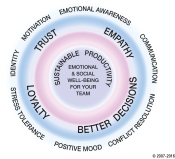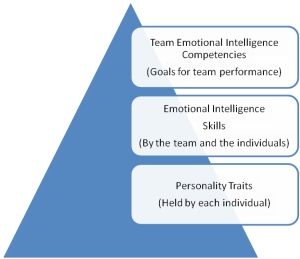 Collaboration is a result of people working together to reach a mutual answer to a challenge or opportunity. As our world becomes more integrated and boundaries become more blurred the need and desire to collaborate is heightened. We see this on the internet, such as with Wikipedia, in organizations of all sizes and shapes, such as the better efforts at the United Nations and in performance goals for individuals and leaders, such as the Executive Core Qualifications (ECQ’s) that leaders in the federal senior executive service are to meet.
Collaboration is a result of people working together to reach a mutual answer to a challenge or opportunity. As our world becomes more integrated and boundaries become more blurred the need and desire to collaborate is heightened. We see this on the internet, such as with Wikipedia, in organizations of all sizes and shapes, such as the better efforts at the United Nations and in performance goals for individuals and leaders, such as the Executive Core Qualifications (ECQ’s) that leaders in the federal senior executive service are to meet.
Organizations frequently list collaboration as part of their mission or vision statement or as one of their values. With all of these forms of embracing collaboration, we know it’s something good, the key question is how do we collaborate and when is it useful? We’ll answer this question for individuals by exploring 10 steps for individuals to follow in order to act collaboratively and briefly review how teams build collaboration.
 Collaborative Intelligence™ is a key outcome teams can reach as they build their skills. Collaborative intelligence is a result teams profit from when using the seven skills measured by the TESI® (Team Emotional and Social Intelligence Survey. When teams build their skills in forming a strong team identity, engaging with motivation, building emotional awareness, enhancing communications, supporting one another in work life balance to manage stress, growing their conflict resolution skills so they can benefit when conflict occurs and act with positive mood they will be engaging multiple strengths and acting collaboratively. Developing these seven skills helps team members learn how to be collaborative and to use this outcome wisely.
Collaborative Intelligence™ is a key outcome teams can reach as they build their skills. Collaborative intelligence is a result teams profit from when using the seven skills measured by the TESI® (Team Emotional and Social Intelligence Survey. When teams build their skills in forming a strong team identity, engaging with motivation, building emotional awareness, enhancing communications, supporting one another in work life balance to manage stress, growing their conflict resolution skills so they can benefit when conflict occurs and act with positive mood they will be engaging multiple strengths and acting collaboratively. Developing these seven skills helps team members learn how to be collaborative and to use this outcome wisely.
Collaboration is a communication and problem solving process that is based on a structured engagement style and process. Those who collaborate well pay attention to personality styles, behavioral engagement strategies, and timing of the decision making as well as who is invited into the discussion, often referred to a stakeholders. Individuals and organizations can act in a collaboratively style informally and accomplish a great deal. More formal collaborative process can be deliberately engaged in more challenging situations and may benefit from engaging a facilitator. Because the process can be slow and deliberative it may be the wrong formal process to use in an emergency, when a quick decision is needed or when the stakes are low, such as choosing where to have lunch. Even in these circumstances when individuals act with a demonstration of inclusivity and intentionally listen to others and incorporate their suggestions as appropriate, they can build buy-in and loyalty that expands their base of support. The following 10 steps will help individuals and leaders be successful in their collaborations. These skills can be integrated into one’s natural behaviors so the benefits of collaboration abound with minimal effort.
10 Steps to Act with Collaborative Intelligence
- Be aware. Notice what is happening so you can choose how you are involved. Breathe deeply to benefit from adding oxygen to your brain, to your heart and to feel calm and resilient.
- Apply Intention and Attention. Form your intention so you know specifically what you want to accomplish and how. Then decide what steps in the process you will pay attention to in order to keep yourself on track. Intend to collaborate, which means intend to work together, to listen and to respond in order to accomplish your goal together. Clarify your own purpose and goals; this is not a process you can accomplish on auto-pilot.
- Commit to the process. Collaboration takes time, energy and patience. If you’re hesitant about using the process you’ll hold back, be protective of “your” information or rush through the process. One way or another without commitment you are most likely to minimize the potential for success. You may end up feeling annoyed or antagonizing others or both.
- Attend to others. Create a foundation for engagement by creating a personal connection. It’s out of little personal discussions where you find you have things in common that form the basis for trusting one another. You might find you both have daughters who sell Girl Scout cookies or you might both climb 14,000 foot mountains. Continue paying attention to other participants throughout the process. Often there is a valuable message behind the specific words someone is using; paying attention will help you discern the real message.
- Mutually establish goals and other criteria. Be sure you are headed in the same direction!
- Express your opinions and share your knowledge. If you keep what you know close to your vest you undermine the ability of everyone to make a good decision, you role model that the process isn’t fully trustworthy and neither are the people involved. Remember your actions speak louder than your words.
- List commonalities and differences. It’s amazing how often people struggle over principles they already all agree on because they didn’t take time to recognize the agreement. If you clarify where there are differences and where you agree then you can begin gathering information to move towards a mutual solution.
- Apply divergent thinking. Be willing to listen to other people’s perspectives even though they may be very different from yours. At attitude of curiosity will be helpful.
- Be appreciative. Keep noticing what works and through this positive process explore what seems to be off-center, to just not work. Explore these inconsistencies with curiosity to find points of agreement.
- Make decision(s). At this point everyone comes to a convergent answer and agrees to support the one answer. Before you sign off though, apply some hearty reality testing. Future pace by imaging it’s sometime in the future and you’re observing how well the decision works. Is anything askew? Did you take on too much at once? Does anything else need adjusting? If so make the changes now.
The result of collaborative decisions is that you have tapped into everyone’s smarts, built trust and have gained mutual commitment to success. What’s not to like about that scenario!













